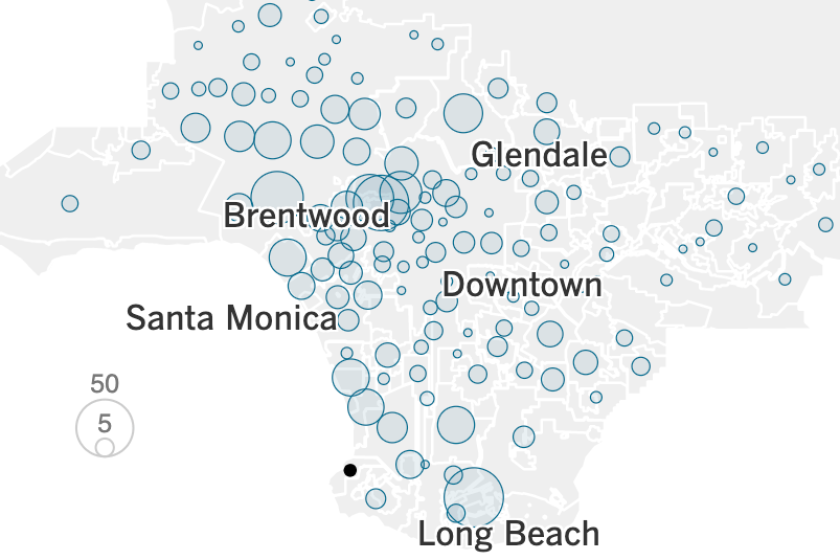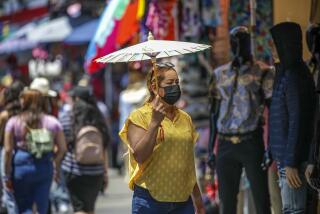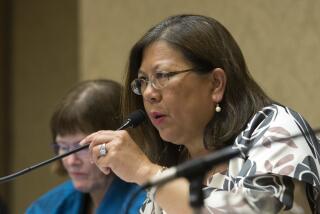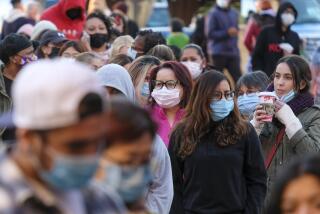Inside the frenzied campaign to get coronavirus supplies to California. Will it be enough?
- Share via
Emergency management officials say they are now moving mountains of protective masks, gloves, gowns and other medical supplies to California hospitals, as the highly coveted gear has started flowing in recent days out of federal, state and local stockpiles.
The vast stores of material, some kept in secret government warehouses, are now getting shipped in massive quantities: 41 million N95 protective masks, 600,000 gowns, 500,000 face shields and more than 2.3 million sets of gloves, according to state emergency officials.
Details about the medical supply chain, which have thus far been shrouded in secrecy, come from confidential state briefings obtained by The Times that explain emergency efforts to keep medical facilities equipped, though the material shipped so far might be just a fraction of what’s needed during the pandemic.
The figures and details about supplies from federal and state stockpiles have been revealed as medical officials and unions representing their workers have also sounded the alarm about shortages of gear for beleaguered caregivers — and as the White House and some governors have clashed about respective preparation for the virus’ impact.
Despite the large quantities, anxiety remains high among doctors and nurses that they might burn through the gear they need as the medical crisis stretches over weeks or months, as many experts expect.
“Now that this shipment is done, and we distributed it, we’re kind of in limbo on when the next one is coming,” said Cathy Chidester, director of the L.A. County Emergency Medical Services Agency, one of the local government entities storing and delivering the gear to hospitals and clinics in their respective areas. “It’s a little tense.”
The state reports help explain a complicated and opaque procurement system, in which federal officials have shipped items and committed other assistance to state emergency officials, who then pass materials on to counties and other local entities. The state reports note that requests from local officials are “very urgent,” and they explain the process for obtaining equipment under this top-down system.
Gov. Gavin Newsom on Saturday said that tens of millions of items had been delivered “in just the last few days”.
“We’ve got a big team that’s been working on this full time, and we’ve had some wonderful success,” he said.
While state officials routinely release summary statistics about the virus’ impact, detailed information about the scale of the crisis in California has otherwise been difficult to acquire.
The California Department of Public Health, for example, has refused to release detailed data on hospitals. Other records about the crisis, such as county-by-county listings of healthcare workers infected with the virus, also remain secret.
The Times has made numerous requests for data that state health officials from various departments have thus far ignored or chosen to decline.
But the governor’s office has touted its supply effort, which appears to be meeting acute needs at some healthcare facilities.
Hospitals in L.A. County, which has had more than 5,000 confirmed COVID-19 cases and more than 100 deaths, have been scrambling to keep their supplies stocked, said Chidester, who is also monitoring bed capacity at 70 hospitals with emergency rooms.
The county’s warehouse managed by Chidester and L.A. County’s Department of Health Services, which oversees a sprawling network of public clinics, providers and hospitals, and has remained a closely guarded secret because of the demand for medical equipment.
When full, the warehouse is packed with brown shipping boxes stacked together on wooden pallets wrapped in plastic, separated in rows across its sprawling floors and reaching into vaulted ceilings.
Inside the facility, county firefighters, lifeguards and disaster response workers enlisted in the distribution effort keep inventory and manage the stores.
Each pallet has shipping instructions for the medical facilities that county officials are trying to help. Those have included various hospitals, elder-care centers and group homes.
The recipients, Chidester said, in the last two weeks have received more than 2.7 million N95 masks, and roughly 2.3 million surgical masks, in addition to gowns and other protective equipment.
Some of the items had come from the county’s general stockpile for medical incidents, stores that were filled long before the coronavirus began its strain on local hospitals. Other items have come from the state’s own emergency inventory. Still more had been passed through the state from federal emergency officials, she said.
The recipients locally have included organizations such as Westside Regional Center, a nonprofit state contractor that helps people with developmental disabilities.
Thanks to a county delivery on Thursday, its Culver City parking lot got transformed into a drive-through distribution hub where its staffers and partners could pick up needed masks.
“The providers were very appreciative,” said Mary Lou Weise-Stusser, Westside’s director of community services. “The masks at least give the staff a little protection. Our biggest fear is that in these congregate living facilities, if one person gets [the virus] or one staffer gets it, we’re looking at a half-dozen people being exposed.”
The masks were among some 7 million distinct items, which also include hundreds of electronic ventilators for patients with critical breathing difficulties that the county has so far received from federal and state officials, Chidester said.
Demand for supplies is high at medical facilities all across the county, where more than 1,200 patients infected with the disease have been hospitalized in recent weeks — including hundreds in intensive care units.
The needs vary by location. At PIH Health hospitals in Downey and Whittier, for example, supplies of hand-sanitizing solution and wipes have run out. But they maintain enough N95 masks to last more than a month, said Jaime Diaz, an emergency physician who serves as the chief medical officer at the Downey facility.
To conserve masks, nurses in COVID-19 wards there are told to use a single N95 mask during the day. Those who don’t work with confirmed or suspected virus patients use simple surgical masks instead. That has extended the lhospital’s N95 supply from four weeks to eight weeks, he said.
Chidester said many hospitals across the region have similar stories. She said she recently scrapped a system allowing the hospitals to submit orders, saying the shipments are leaving as quickly as possible upon arrival. The county had delivered most of its supplies by the end of last week.
She said their delivery totals sound impressive until you remember the scores of facilities across the county — and how often doctors and nurses dispose of the equipment.
“It’s small compared to the need because of the burn rate. The burn rate kills you. Every time you see a patient, you have a certain gown on. You can walk into the person’s room for five minutes, and when you come out, you’ve got to take that gown off and dispose of it. And the same with the gloves: off and on, off and on,” she said.
In addition to supporting that operation, the county has had to decipher messages from scores of businesses offering to sell their medical products to the county amid the disaster. Some haven’t been reputable, she said, while others couldn’t guarantee that their products would meet federal standards.
Newsom on Saturday said his office is also seeking to improve the process for prospective contractors and volunteers to offer their gear. His team launched a new website, covid19supplies.ca.gov, where businesses and others leave information about their products.
Federal officials have been reluctant to discuss their inventory of emergency items, known as the Strategic National Stockpile, citing national security concerns. But they say those goods are flowing to local communities under the system.
In response to questions from The Times, the Federal Emergency Management Agency this week said it had set aside nearly $500 million to help California with the cost of responding to the coronavirus — part of a broader $860 million aid plan so far.
The agency also confirmed that about half of its estimated 16,000 to 20,000 ventilators have been shipped across the country, including where some governors have expressed fear that their hospitals may run out of the live-saving devices if the crisis worsens.
More than 100 ventilators arrived in L.A. County last month with dead batteries, The Times has learned. State officials later helped to refurbish them.
Governors and public health officials have urged President Trump to invoke the Defense Production Act to force companies to more quickly build ventilators and protective gear, and supply them to states and hospitals facing the most dire situations. Trump has resisted taking such a step, saying he would prefer to use the act as leverage to persuade manufacturers and distributors to join what he has described as a war effort.
Trump has used the act three times — to force General Motors to build ventilators; to direct the Department of Health and Human Services to ensure that ventilator makers get first access to critical parts; and to order 3M to prioritize orders for N95 masks from the federal government.
Experts said such actions have been too limited to address what they have described as a nationwide shortage of essential equipment.
Former federal officials have described the Trump administration’s efforts as being chaotic and haphazard, as agencies and White House personnel pursue different agendas. Health experts and former federal officials have urged Trump to create a unified command and control structure to spur production and delivery of masks, gowns and ventilators.
“We need a command and control operation at the very top of the government, run by someone like George C. Marshall,” the general who helped lead the nation’s World War II response, said Tara O’Toole, a former Department of Homeland Security official who helped lead an outside review of the national stockpile from 2016 to 2018. “Someone has to be in charge with full authority.”
So far Newsom has sought to project that authority in California, holding regular virtual press briefings and touting his administration’s efforts not just on delivering gear — but also on tracking the numbers of beds available in hospitals across the state and planning to help vulnerable groups, such as the homeless.
He also hasn’t too vocally complained about the federal effort. Newsom told CNN last week that the state is using its own purchasing power to keep the equipment flowing as the crisis continues.
“States are getting a little bit of support, but we’re going to have to be resourceful,” he said.
Times staff writer Harriet Ryan contributed to this report.
More to Read
Sign up for Essential California
The most important California stories and recommendations in your inbox every morning.
You may occasionally receive promotional content from the Los Angeles Times.














